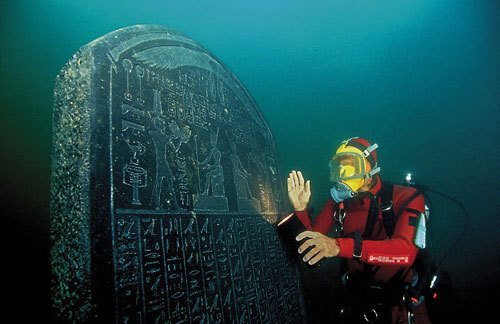A new exhibit at London's British Museum is introducing visitors to the gods of Egypt via the depths of the Mediterranean Sea. 'Sunken Cities: Egypt's Lost Worlds' features hundreds of relics from two Egyptian cities rediscovered beneath the seabed.
This colossal statue of Hapy (pron. "Happy"), God of the Nile Flood, was discovered underwater in what was the thriving ancient Egyptian seaport of Thonis-Heracleion.

'Sunken Cities: Egypt's Lost Worlds' -British Museum
He's the star attraction of this new exhibit which tells the tales of two ancient-Egyptian cities recently rediscovered beneath the seabed.
The European team that found Hapy was led by Franck Goddio, director of the European Institute for Underwater Archeology.
"We came across an unbelievable statue - the statue of Hapy - it was broken into pieces, but when we found the face of that god, it was an unbelievable instant," said Franck Goddio, Director of European Institute for Underwater Archeology.
Ancient writings and Greek mythology record the cities of Thonis-Heracleion and Canopus, but for centuries they were believed to be lost.
But after sightings from a plane, a diving survey was organised in 1993, leading to the rediscovery in 1996.
Finds suggest the cities were inhabited until around 700 AD, but disappeared as a result of gradual subsidence into the sea - similar to that now being experienced in the Italian city of Venice today.
Between 1996 and 2012, the team continued to excavate the seabed. Over 200 finds are now on display at the British Museum, including statues, metalware, and gold jewellery. Due to the underwater setting, they are unusually well preserved.
This 300 BC statue of queen and goddess, Arsinoe II, from Canopus reveals a fusion of Egyptian and Greek styles.
But around half of the exhibition is dedicated to Osiris, the ruler of the underworld and one of the most important and popular gods in ancient Egypt.
For example, these models of barges, uncovered in a sacred waterway linking the two cities, are associated with the Mysteries of Osiris, an annual festival once celebrated across Egypt.
"We knew about the Mysteries of Osiris long before, because this was detailed in Egyptian sacred text or depicted on sacred walls of temples, so we knew that they were celebrated," said Lead curator Aurelia Masson-Berghoff.
And there could be many more mysteries to uncover, as the archeologists estimate only about five percent of the sites has been excavated so far.















